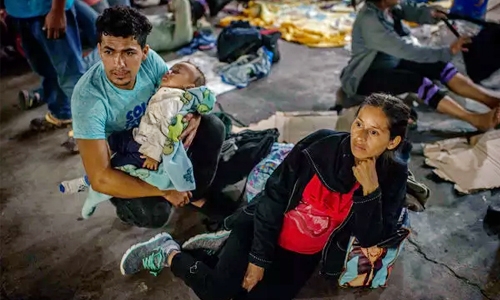‘Criminals?’ hardly: That’s who the caravan flees
As thousands of Honduran migrants seeking asylum in the United States trek northward through Mexico, President Donald Trump has pledged to stop them at the border by militarising it with armed federal troops, under the guise of protecting Americans from “criminals” and an “invasion.” What he fails to recognise is that cruelty won’t solve the current refugee crisis. Neither will buddying up with authoritarian leaders in Central America.
Instead, those two strategies only deepen the crisis, because criminality and misrule are exactly what the caravan is fleeing. What Trump calls an invasion is actually the visible face of a deadly crisis of governance and violence in almost all of Central America — a retreat from the rule of law in favour of rule by corruption and criminality abetted by officials with impunity. For example, Trump supports President Jimmy Morales, his authoritarian counterpart in Guatemala.
Morales is under investigation for possible corruption by the United Nations Commission Against Impunity in Guatemala. He has fought back by revoking the visas of many of the commission’s investigators. Currently, violence reigns in Honduras, Guatemala and El Salvador; the three countries have the world’s highest homicide rates, and the pattern they have set — daily killings, forced gang recruitment, extortion, gender attacks and kidnapping for ransom — may be creeping into Nicaragua. The criminal groups behind this are a legacy of civil wars fought in the 1970s and 1980s, and of past military regimes that left 75,000 dead in El Salvador and 200,000 dead in Guatemala.
Honduras, which has been a base for American military operations in Central America for decades, is now considered the most violent. Unlike Guatemala and El Salvador, it has never even had an official counting of the dead. In those three northern Central American countries, military units are entrenched in a complex web of organised crime, drug trafficking, gangs, political parties and corrupt clandestine police groups. The gangs have ties to the police — who hunt gang members if they don’t pay their quota or become liabilities because they know too much after colluding with corrupt police officers.
The gangs also have ties to organised crime and drug traffickers who, in turn, have their own ties to the military and the police. In the 1980s, gang members informed the police about factory workers, union organisers, teachers and students involved in political protest. In exchange, the police granted the gangs neighbourhood territory for illicit activities. In Guatemala, after peace accords in the 1990s ended a decades long civil war, clandestine groups with ties to police and army officials used army routes, landing strips and heliports to transport weapons and drugs.
Guatemala’s networks illustrate how tightly interwoven those systems can become. For example, gangs pay the police to ignore the gang operations in their territories. Those payments flow upward: Local police officers pay their boss, who in turn pays off his boss. At the higher levels, drug traffickers might buy the services of a very senior police officer, who in turn might then send payments downward, to individual officers. Narco-traffickers and crime syndicates also pay off gang members to support illicit trafficking and to assert their power; the jobs vary from hit man, kidnapper, extortionist, arsonist, carjacker and recruiter of low-level supporters of criminal activities.
The interlocking power structures of violence, bribes, threats and patronage make everyday life extremely dangerous for Central Americans. Any interaction between gang members and ordinary citizens carries two meanings. The first: “Will you give me that money?” Answering “no” is seen as a direct challenge to the gang’s power. The second: “Do you accept my control over your life?” Refusing to give up even one dollar can designate a person an enemy of the gang, which is a very dangerous position to be in. Central American governments know all this. Their responses range from turning a blind eye to crime, to corrupt acceptance, to active complicity.
Members of the elite work within and dominate these violent power structures. And many of these clandestine groups have ties to Mexico’s horrifically violent drug cartels. This dark picture of what Central Americans seek to escape is not a new experience in American immigration. It recalls other horrors that forced human waves — Irish, Italian, Greek, Jewish, Hungarian, German, Polish and more — to flee parts of Central and Southern Europe for America rather than endure violence, crime, discrimination, misgovernment and hunger in the 19th and early 20th centuries. Did America lose by welcoming them? Think about just how much those grateful newcomers have added to the fabric of American society.
Like the great majority of those masses, today’s Central Americans seek merely to live in safety, to work hard and to provide for their families. They are not criminals, as Trump would have it. They are the victims of criminal enterprises that only pretend to govern. If Trump, nevertheless, insists on stemming the flow of refugees, he must at least show America’s compassion for them and insist that their home countries adopt reforms that produce honest and law-abiding governments. He should support the efforts of the anti-impunity commission for Guatemala.
And he should answer the call of citizens of Mexico, El Salvador, Honduras and Nicaragua who have sought to expand the commission to a regional United Nations Commission Against Impunity. The Honduran caravan is a call for help in ending violence and impunity, and replacing it with the rule of law. Those are the commission’s goals for Guatemala. Trump and Congress must strengthen those efforts and help them become a regional campaign to rein in rule by criminal cliques and murderous gangs that make daily life intolerable for the average citizen. Ensuring fair elections is also needed, of course. But elections are meaningless without rule of law.
Related Posts

